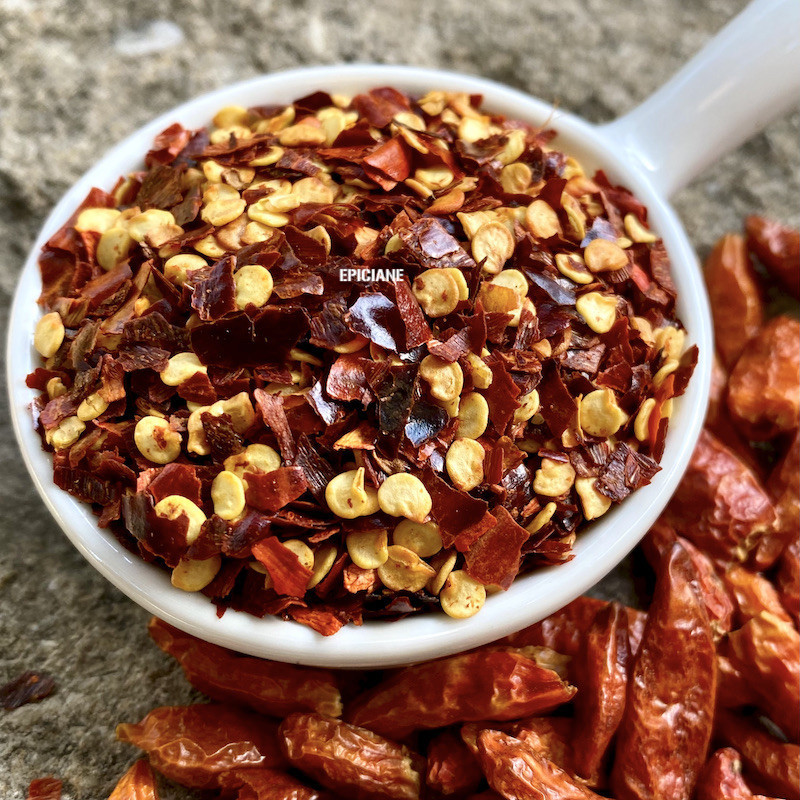
Reference: 30811001


Just like whole hot peppers, it’s truly fiery—and that’s exactly what we’re after!
It’s used to make spicy oils or to enhance dishes like calamari, paellas, or shellfish broths.
 Delivery
Delivery
Mondial Relay
 Returns
Returns
See conditions
 Payments
Payments
100% secure
Livré en sachet refermable
Culinary Uses:
Crushed hot pepper is made by chopping whole peppers to create a “crushed” form, giving it a fiery heat that’s precisely what people look for in this spice! Use it sparingly, but it brings an exciting, unique “pep” to nearly any savory dish in the world, and even to some sweet treats, as it’s occasionally found in chocolate—just in small amounts, of course!
In its coarsely chopped form, it disperses well in dishes and is ideal for making spicy oils, as it infuses both heat and flavor faster than whole peppers due to its larger surface area. Making these spicy oils at home is easy; simply use a basic olive oil (olive oil captures flavors better than other oils) and add a tablespoon of crushed hot pepper, along with herbs if desired, and let it steep for at least 15 days, shaking the bottle occasionally. Use this oil on pizzas or to start the cooking of various meat or fish dishes for added flavor without overwhelming spiciness.
Crushed hot pepper is also perfect for ratatouille, tomato sauces, calamari and shellfish dishes, various meat recipes, and countless other preparations.
Who Am I?
Origin: India
Scientific Name: Capsicum frutescens, Capsicum annuum
Common Names: Hot pepper, bird’s eye chili, pili-pili
Crushed hot pepper is obtained by cutting and sieving whole peppers, resulting in 2-5mm red pieces with visible yellow seeds, whose quantity may vary between batches.
Like all peppers and chilies, crushed hot pepper belongs to the Solanaceae family (along with tomatoes and eggplants) and, like them, originates from Central and South America. Despite sometimes being called “Cayenne pepper,” it’s not cultivated in Cayenne! Instead, it’s been grown in tropical climates worldwide for centuries.
If hot pepper is accidentally consumed in excess, drinking water won’t help, as capsaicin (responsible for the heat) isn’t water-soluble. Instead, drink milk, as capsaicin binds to the milk protein casein and is thus more quickly eliminated.
Hot pepper helps the body better withstand extreme heat, which tropical populations have long understood. However, be careful not to rub your eyes or mucous membranes after handling hot pepper without thoroughly washing your hands first, as it can cause intense burning! Nonetheless, it has many health and digestive benefits when used in moderation.
Researchers have discovered with surprise that peppers “defend” themselves by becoming spicier in areas with more predators (insects or even parasitic fungi).
In the West, it’s mainly used externally (rubs or poultices) for its effects on arthritis and osteoarthritis pain relief.
Hot pepper is also said to have bactericidal properties, and eating it in hot climates can greatly reduce the risk of intestinal infections. It also stimulates blood circulation and promotes sweating.
A Bit of History:
Hot pepper, often referred to as "Cayenne pepper," doesn’t actually come from Cayenne! This name simply designates this very hot variety of pepper.
The Aztecs called it “chili,” a name that has stuck in English and German. For over 9,000 years, it was known to the indigenous peoples of equatorial America, where it originated, for its culinary and medicinal properties.
It was a companion of Christopher Columbus who introduced the plant to Europeans after a journey intended for the Indies, which instead ended in the Caribbean. The plant was then quickly spread to all equatorial regions of the globe and was adopted in Asia, the Middle East, and Africa.
Data sheet
Reference: 30811001
Reference: 00033663-0001
Reference: 10707402
Reference: paprika
Reference: 00033663-0001
Reference: 10814501
Reference: 508212501
Reference: pilipili
Reference: paprikafumé
Reference: 20813701
Reference: 10707402

Just like whole hot peppers, it’s truly fiery—and that’s exactly what we’re after!
It’s used to make spicy oils or to enhance dishes like calamari, paellas, or shellfish broths.